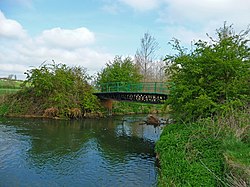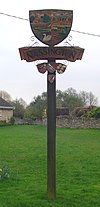Nassington: Difference between revisions
No edit summary |
m clean up, typos fixed: a 16th century → a 16th-century (3) |
||
| Line 27: | Line 27: | ||
The Prebendal Manor House, one of the most historic properties in Northamptonshire; it is the earliest surviving dwelling in Northamptonshire (and a Grade I listed building). The house stands close by the parish church on a promontory in a bend in the river. | The Prebendal Manor House, one of the most historic properties in Northamptonshire; it is the earliest surviving dwelling in Northamptonshire (and a Grade I listed building). The house stands close by the parish church on a promontory in a bend in the river. | ||
It forms the focus of a group of stone buildings, which includes a 16th century dovecote, a large 18th century tithe barn and a 15th century lodgings building. | It forms the focus of a group of stone buildings, which includes a 16th-century dovecote, a large 18th century tithe barn and a 15th-century lodgings building. | ||
Excavations in and around the Prebendal Manor at Nassington have been in progress since 1984. The accumulated archaeological data demonstrates that the Prebendal site has been used and occupied since the Stone Age. Bronze Age finds and an Early Iron Age field and fence system have been found, and Roman pottery suggesting a farmstead on the manor site. Excavations close to the southern boundary of the church uncovered the remain of a Late Saxon timber aisled hall. | Excavations in and around the Prebendal Manor at Nassington have been in progress since 1984. The accumulated archaeological data demonstrates that the Prebendal site has been used and occupied since the Stone Age. Bronze Age finds and an Early Iron Age field and fence system have been found, and Roman pottery suggesting a farmstead on the manor site. Excavations close to the southern boundary of the church uncovered the remain of a Late Saxon timber aisled hall. | ||
| Line 48: | Line 48: | ||
The plant list tells what was grown on each of four sides of his garden. Where there is any uncertainty as to which plant is meant in the original documents, then the possible alternatives have been planted. | The plant list tells what was grown on each of four sides of his garden. Where there is any uncertainty as to which plant is meant in the original documents, then the possible alternatives have been planted. | ||
The plants have been selected from several plant lists. These include the earliest gardening book by 'Jon Gardener' and a 15th century 'Leech Book' that contains the sort of medical recipes that Nicholas Colnet, who was physician to Henry 5th during the Agincourt campaign in 1415. He was given the Prebendal Manor in 1417, probably in return for his services. There is a plant identification list to accompany this garden. | The plants have been selected from several plant lists. These include the earliest gardening book by 'Jon Gardener' and a 15th-century 'Leech Book' that contains the sort of medical recipes that Nicholas Colnet, who was physician to Henry 5th during the Agincourt campaign in 1415. He was given the Prebendal Manor in 1417, probably in return for his services. There is a plant identification list to accompany this garden. | ||
Alan Titchmarsh described the gardens as a "stunning example of a recreated mediæval garden". | Alan Titchmarsh described the gardens as a "stunning example of a recreated mediæval garden". | ||
Latest revision as of 18:34, 28 January 2016
| Nassington | |
| Northamptonshire | |
|---|---|
 River Nene near Nassington | |
| Location | |
| Grid reference: | TL0696 |
| Location: | 52°33’21"N, 0°25’50"W |
| Data | |
| Population: | 670 |
| Post town: | Peterborough |
| Postcode: | PE8 |
| Dialling code: | 01780 |
| Local Government | |
| Council: | North Northamptonshire |
| Parliamentary constituency: |
Corby |
Nassington is a village in Northamptonshire, a place of just 670 souls recorded at the 2001 census. It sits in the north-east of the county and on the bank of an arm of the River Nene, which river forms the border with Huntingdonshire. Immediately to the north is Yarwell, a village of similar size, and between them the embankment of a dismantled railway. The River Nene runs along the eastern side of the parish.
Here in Nassington is the Prebendal Manor House, one of the most historically valuable buildings in the county. The modern village property boundaries still retain much of their early mediæval origins and the manorial plot can still be distinguishable as a large block of land, with the church occupying the northeast corner.
Parish church
The parish church is St Mary the Virgin and All Saints. It stands on a promontory over looking the village, and may once have been a minster church. St Mary's, has an Anglo-Saxon tower and a Norman nave.
The base of an Anglo-Saxon standing cross dated to the late ninth century was discovered when the church was restored in the 19th century. The two surviving Anglo-Saxon features in the church appear to be of different dates and it is suggested that the tower may be dated earlier than the nave with its surviving long and short quoins, which possibly replaced an earlier nave. The Saxon tower which, was encased by outer facing in the late 12th century, is dated to the 11th century.
Prebendal Manor House
- Main article: Prebendal Manor House
The Prebendal Manor House, one of the most historic properties in Northamptonshire; it is the earliest surviving dwelling in Northamptonshire (and a Grade I listed building). The house stands close by the parish church on a promontory in a bend in the river.
It forms the focus of a group of stone buildings, which includes a 16th-century dovecote, a large 18th century tithe barn and a 15th-century lodgings building.
Excavations in and around the Prebendal Manor at Nassington have been in progress since 1984. The accumulated archaeological data demonstrates that the Prebendal site has been used and occupied since the Stone Age. Bronze Age finds and an Early Iron Age field and fence system have been found, and Roman pottery suggesting a farmstead on the manor site. Excavations close to the southern boundary of the church uncovered the remain of a Late Saxon timber aisled hall.
The manor was, until the Victorian period, a prebend, which is to say an endowment held by the church to maintain an officer of the cathedral, a 'prebendary', who acted as lord of the manor. This prebend was created by a grant from King Henry I to the Diocese of Lincoln and, apart from an interruption under Cromwell, was maintained until the abolition of prebends in 1836. The manor was sold by the Church Commissioners in 1875 and has been in private ownership since then.
In the grounds of the manor are several mediæval and Georgian buildings of interest. The eighteenth century tithe barn contains a private museum.
Gardens
The gardens of the Prebendal Manor House were established to represent both the practical and decorative features that could be found in a high status garden between the 13th and 15th centuries.
The New Garden is based on the 'Square Garden of Henry the Poet'. Henry was most likely to have been, 'Henricus Anglicus', who is known to have travelled to Naples and many other places. Henry Daniel praising him as 'Doctor and noble poet', quoted his writing on herbal recipes.
The ephemeral beauty of gardens was noted by many mediæval poets:
'Now shrinketh rose and lilye-flour,
That whilen ber that swete savour.
In somer, that swete tide.'
The plant list tells what was grown on each of four sides of his garden. Where there is any uncertainty as to which plant is meant in the original documents, then the possible alternatives have been planted.
The plants have been selected from several plant lists. These include the earliest gardening book by 'Jon Gardener' and a 15th-century 'Leech Book' that contains the sort of medical recipes that Nicholas Colnet, who was physician to Henry 5th during the Agincourt campaign in 1415. He was given the Prebendal Manor in 1417, probably in return for his services. There is a plant identification list to accompany this garden.
Alan Titchmarsh described the gardens as a "stunning example of a recreated mediæval garden".
Tithe Barn Museum
The Tithe Barn Museum stands in the gorund of the manor house. It is managed as a registered charity.
The museum displays the history of the manor and of the prebendaries. There are recreated mediæval gardens and photographs of both the manor and the gardens.
History
There are considerable signs of Roman occupation in the parish: archaeology has found a large village of the period near the Fotheringhay parish and Roman iron-workings near the road between Wansford and Kings Cliffe. An important Roman town stood nearby, namely Durobrivae by Water Newton across the river in Huntingdonshire.
Nassington was a royal manor in Anglo-Saxon times, and the parish church contains an Anglo-Saxon tower and some elements of sculpture form that time. There was a lordly hall here, and King Canute is known to have visited his estate in Nassington at some time after 1017. Excavation has shown that the Anglo-Saxon long hall was on the site of today's manor house. The Prebendal Manor House of today is the oldest manor house in the county and claims to be one of the longest continually inhabited in Britain, in succession to the Anglo-Saxon hall.
In 1123 Henry I granted the churches of Nassington, Woodnewton, Tansor, and Southwick to St Mary’s of Lincoln, and Bishop Robert "in prebendam and the church and bishop shall hold them as Leving, the kings’ scribe, best held them." The man named, Leving, was the rector of Nassington at this time. It is thought that improvements to the hall were made by the church around 1160.
In 1777-1788 an inclosure award transformed the parish's agriculture.
In the 19th century the railway came, scything through the landscape immediately north of Nassington and crossing the Riiver Nene on a many-arched viaduct, which was demolished only in 1981.
On television

The village was featured in episode 117 of Time Team (airing 7 March 2004). The goal of the excavation was 'King Cnut's Manor'.
Outside links
| ("Wikimedia Commons" has material about Nassington) |
- Prebendal Manor and Tithe Barn Museum
- Britain Express: Prebendal Manor House, Nassington
- Nassington on ‘British History Online’
